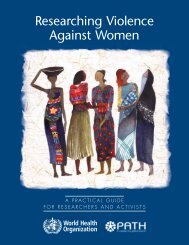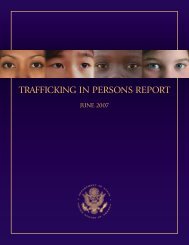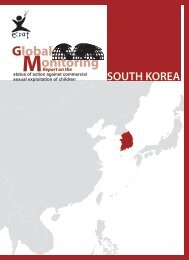Download PDF - Violence Against Children - East Asia and the ...
Download PDF - Violence Against Children - East Asia and the ...
Download PDF - Violence Against Children - East Asia and the ...
Create successful ePaper yourself
Turn your PDF publications into a flip-book with our unique Google optimized e-Paper software.
Indonesia<br />
building strategies can be very effective in<br />
communities recovering from violent<br />
conflict.<br />
4. However, peace building strategies need<br />
to consider a greater focus on processes<br />
than on concrete objectives. Activities<br />
that work on <strong>the</strong> latter (e.g. improving<br />
physical infrastructure such as roads<br />
between formerly conflicting<br />
communities) could result in harm, if<br />
time-consuming consensus building <strong>and</strong><br />
organisational processes focusing on trust<br />
<strong>and</strong> confidence building have not been<br />
prioritised.<br />
5. Good governance practices are<br />
foundational to building peaceable<br />
communities. Key elements are good<br />
leadership, community participation in<br />
decision-making, <strong>and</strong> principles of<br />
restorative justice. 13<br />
6. Trust <strong>and</strong> responsible use of power are<br />
more likely to occur in contexts where<br />
equitable social <strong>and</strong> economic<br />
development occurs. A clear<br />
underst<strong>and</strong>ing of <strong>the</strong>se dynamics is<br />
important when planning projects. 14<br />
Barriers<br />
• Estrangement: The legacy of conflict has<br />
been increased tension, reduced exchanges<br />
between groups, <strong>and</strong> children isolated<br />
within <strong>the</strong>ir communities. Travel carries<br />
increased risk, which limits projects<br />
regarding location <strong>and</strong> scope of operation.<br />
• Poor social policy: Active civil society<br />
engagement with government on emerging<br />
social policy requires greater support from<br />
key players. The potential impact of this is<br />
significant, <strong>and</strong> warrants greater priority in<br />
<strong>the</strong> interests of influencing a sound<br />
legislative framework.<br />
• Sensitivity on issues that may inflame old<br />
tensions leading to fur<strong>the</strong>r violence <strong>and</strong><br />
displacement. This is sometimes an<br />
inevitable barrier as engagement itself is a<br />
risk which, if not taken, results in avoidance<br />
<strong>and</strong> inaction. Opportunity exists to build on<br />
successful peer education methods in<br />
promoting peace; materials could be used to<br />
introduce some of <strong>the</strong> curriculum to <strong>the</strong><br />
library. Indicators could be developed which<br />
may help monitor <strong>the</strong> fortunes of children<br />
who are IDPs.<br />
• Poor legal protection for children: There<br />
is a need to improve laws <strong>and</strong> <strong>the</strong>ir<br />
application to adequately protect women<br />
<strong>and</strong> children, as has recently been<br />
acknowledged by government. As part of<br />
this, a dedicated position to promote<br />
government response on child protection is<br />
needed for fur<strong>the</strong>r progress to be made,<br />
<strong>and</strong> NGOs like World Vision may lead a<br />
process of advocacy.<br />
• Capacity of staff <strong>and</strong> partners: Building<br />
capacity is a cross-cutting issue for all<br />
countries. Creative partnerships are<br />
needed to develop new methods, as well<br />
as to optimise use of those already<br />
developed. “Localising” resources from<br />
o<strong>the</strong>r areas is well underway in World<br />
Vision Indonesia, with a focus on training,<br />
working groups <strong>and</strong> translation. Most<br />
importantly, access to materials which are<br />
in a local language <strong>and</strong> which are practically,<br />
not academically, oriented is essential.<br />
• Long-term engagement: A consistent<br />
presence in a changeable environment is<br />
necessary for long-term stability <strong>and</strong><br />
development in post-conflict societies. The<br />
risk faced is that tensions encountered<br />
affect every aspect of a development<br />
activity, to <strong>the</strong> point of inaction or<br />
withdrawal. Agencies <strong>and</strong> donors alike<br />
need to recognise that long-term<br />
commitment is needed to engage <strong>the</strong> areas<br />
where <strong>the</strong>re is greatest uncertainty for<br />
greater impact.<br />
13 Numerous websites about restorative justice include <strong>the</strong> International Centre for Justice <strong>and</strong> Reconciliation’s Restorative Justice Online<br />
(http://www.restorativejustice.org/), which states: “Restorative justice is a systematic response to crime that emphasises healing <strong>the</strong> wounds of victims,<br />
offenders <strong>and</strong> communities caused or revealed by <strong>the</strong> criminal behaviour. Practices <strong>and</strong> programs reflecting restorative purposes will: (a) identify <strong>and</strong> take<br />
steps to repair harm done, (b) involve all stakeholders, <strong>and</strong> (c) transform <strong>the</strong> traditional relationship between communities <strong>and</strong> <strong>the</strong>ir governments.”<br />
14 World Vision Indonesia’s Reconciliation <strong>and</strong> Peacebuilding Adviser, 2002<br />
56

















